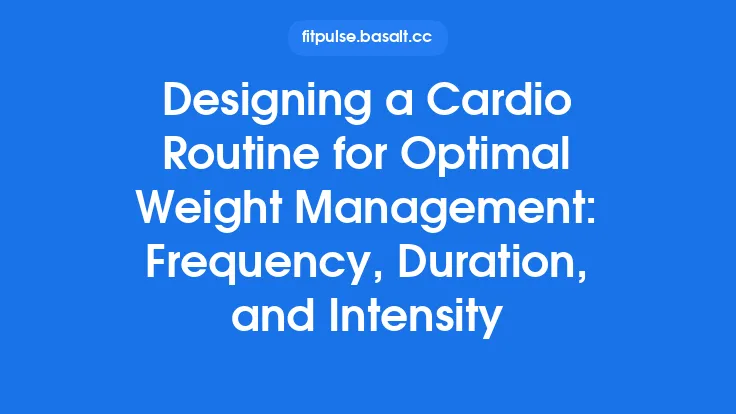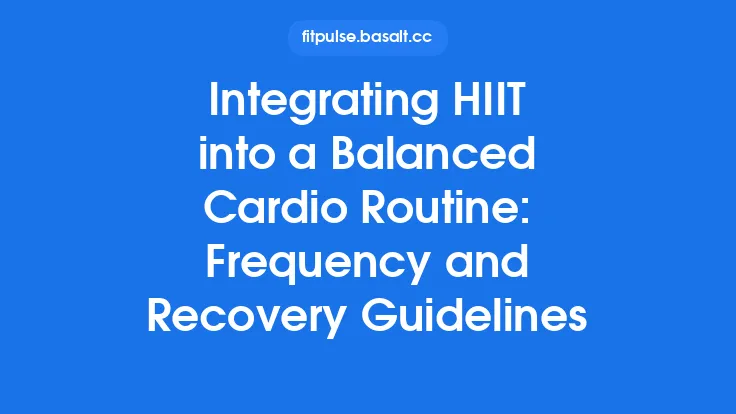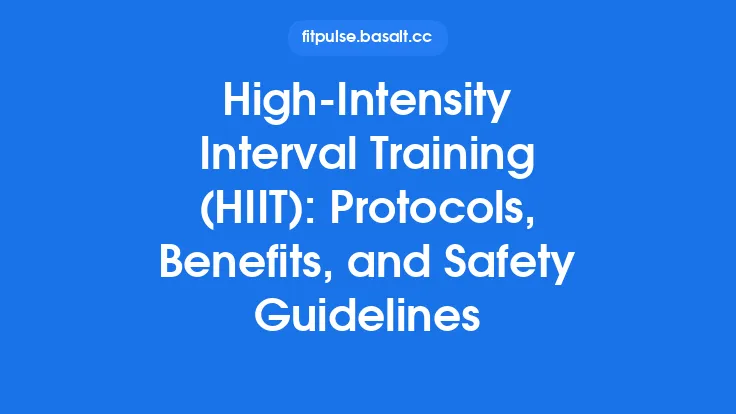Cardiovascular conditioning is one of the most powerful tools for maintaining overall health, yet the optimal “dose” of cardio—how often you should train, how long each session should last, and how hard you should work—varies dramatically across the lifespan. Understanding the physiological shifts that occur from childhood through the senior years allows you to tailor your cardio regimen to the unique needs of each age group, maximizing heart‑health benefits while minimizing unnecessary strain.
Youth (Ages 6‑17)
Frequency
During the developmental years, the heart and circulatory system are highly adaptable, and regular aerobic activity supports not only cardiovascular health but also growth, cognitive development, and emotional well‑being. The consensus among pediatric health organizations recommends at least 5 days per week of moderate‑to‑vigorous aerobic activity. For children who are already active in sports or extracurricular activities, this can be consolidated into 3‑4 longer sessions, provided the total weekly volume meets the recommended threshold.
Duration
The total weekly aerobic volume should approximate 60 minutes per day of moderate‑intensity activity, or 30‑45 minutes of vigorous activity. When structuring sessions, aim for 30‑45 minute blocks for moderate work, or 20‑30 minute blocks for vigorous work. Shorter “burst” periods (e.g., 10‑minute active play) can be accumulated throughout the day to meet the total target, especially for younger children whose attention spans may favor varied, intermittent activity.
Intensity
Intensity is best expressed relative to a child’s maximal heart rate (HRmax). A practical formula for estimating HRmax in youth is 220 – age, though research suggests a slightly higher value (≈ 225 – age) may be more accurate for adolescents.
- Moderate intensity: 50‑70 % of HRmax (e.g., a 12‑year‑old with an estimated HRmax of 208 bpm should aim for 104‑146 bpm).
- Vigorous intensity: 70‑85 % of HRmax (e.g., 146‑177 bpm for the same child).
Children can gauge intensity through the “talk test”: during moderate activity they can speak in full sentences; during vigorous activity they can speak only short phrases.
Why These Numbers Matter
- Cardiac remodeling: Regular moderate‑to‑vigorous activity stimulates beneficial enlargement of the left ventricle, improving stroke volume without overloading the immature myocardium.
- Metabolic health: Consistent aerobic exposure enhances insulin sensitivity and lipid profiles, establishing a protective metabolic foundation that persists into adulthood.
- Neurocognitive benefits: Aerobic exercise increases cerebral blood flow and neurotrophic factors, supporting attention, memory, and academic performance.
Adult (Ages 18‑64)
Frequency
For the adult population, the primary goal is to sustain cardiovascular fitness while balancing work, family, and other commitments. The evidence‑based recommendation is 3‑5 days per week of aerobic activity. This range provides flexibility: a busy professional may opt for three longer sessions, whereas an active individual may prefer five shorter sessions.
Duration
The classic guideline of 150 minutes of moderate‑intensity or 75 minutes of vigorous‑intensity cardio per week remains the gold standard. Adults can achieve this through:
- Moderate‑intensity: 30‑45 minute sessions, 5‑6 days per week.
- Vigorous‑intensity: 20‑30 minute sessions, 3‑4 days per week.
If time constraints are a concern, high‑intensity interval training (HIIT)—short bursts of near‑maximal effort followed by recovery—can deliver comparable cardiovascular adaptations in as little as 10‑20 minutes per session, provided the total weekly volume meets the intensity‑adjusted equivalence.
Intensity
Adult intensity is most accurately prescribed using a percentage of HRmax or heart‑rate reserve (HRR). The standard HRmax formula (220 – age) is acceptable for most adults, though a more precise estimate (208 – 0.7 × age) reduces error for older adults.
- Moderate intensity: 40‑60 % of HRR (or 50‑70 % of HRmax).
- Vigorous intensity: 60‑85 % of HRR (or 70‑85 % of HRmax).
For those using perceived exertion, the Borg Rating of Perceived Exertion (RPE) scale is useful: 12‑13 for moderate, 14‑16 for vigorous.
Rationale for These Parameters
- Endothelial function: Regular moderate‑intensity work improves nitric oxide availability, enhancing arterial compliance.
- Cardiac output: Vigorous sessions increase maximal cardiac output and VO₂max, which are strong predictors of longevity.
- Weight management: The cumulative caloric expenditure from the recommended volume supports energy balance, reducing the risk of obesity‑related cardiovascular disease.
Senior (Ages 65+)
Frequency
Older adults benefit from most days of the week—ideally 5‑7 days—to maintain consistent circulatory stimulation. Daily activity, even at low intensity, helps counteract age‑related declines in autonomic regulation and arterial elasticity.
Duration
The target weekly volume mirrors adult recommendations but is often achieved through shorter, more frequent bouts:
- Moderate intensity: 150 minutes per week, broken into 20‑30 minute sessions.
- Vigorous intensity (if medically cleared): 75 minutes per week, in 15‑20 minute sessions.
For seniors who cannot sustain continuous activity, multiple 5‑10 minute intervals throughout the day are acceptable, provided the total weekly duration is met.
Intensity
Because maximal heart rate declines with age, intensity should be expressed relative to HRmax or HRR, using age‑adjusted formulas:
- HRmax ≈ 208 – 0.7 × age.
- Moderate intensity: 40‑55 % of HRR (or 50‑65 % of HRmax).
- Vigorous intensity: 55‑70 % of HRR (or 65‑80 % of HRmax).
When heart‑rate monitoring is impractical, the talk test remains reliable: seniors should be able to converse comfortably during moderate activity and speak in short phrases during vigorous activity.
Why These Guidelines Are Critical for Seniors
- Preservation of stroke volume: Regular aerobic work mitigates the age‑related reduction in left‑ventricular compliance, helping maintain cardiac output.
- Blood pressure regulation: Consistent moderate activity lowers systolic pressure by improving baroreceptor sensitivity.
- Functional independence: Adequate aerobic conditioning supports gait speed, balance, and overall mobility, reducing fall risk.
Cross‑Age Considerations
1. Progressive Load Management
While the article does not delve into detailed programming, it is essential to recognize that gradual increases in frequency, duration, or intensity are safer and more sustainable across all ages. A typical progression might involve adding 5‑10 minutes to weekly duration or 5‑10 % to intensity every 2‑4 weeks, depending on individual recovery capacity.
2. Individual Variability
Genetics, health status, and lifestyle factors (e.g., occupational activity, sleep quality) influence how each person responds to cardio dosing. Therefore, the presented ranges should be viewed as starting points rather than rigid prescriptions. Adjustments based on personal feedback—such as fatigue levels, heart‑rate recovery, and overall well‑being—are essential.
3. Health Screening
Before initiating any new cardio regimen, especially for vigorous work, individuals in all age groups should obtain medical clearance if they have known cardiovascular disease, hypertension, diabetes, or other chronic conditions. This ensures that the prescribed intensity aligns with current health status.
4. Environmental Factors
Temperature, altitude, and air quality can affect perceived exertion and heart‑rate response. On hot or polluted days, it may be prudent to reduce intensity or shorten duration, regardless of age.
Practical Implementation Tips
- Use a simple log: Record the day, duration, and perceived intensity (e.g., “moderate” or “vigorous”). Over time, patterns emerge that help fine‑tune the regimen.
- Leverage technology wisely: Wrist‑based heart‑rate monitors can provide real‑time feedback, but remember that absolute accuracy varies; use them as guides rather than definitive measures.
- Mix modalities: Walking, cycling, swimming, and low‑impact elliptical work all satisfy aerobic criteria. Rotating activities can reduce monotony and distribute joint stress.
- Plan for recovery: Even though the focus is on frequency, incorporating at least one active‑recovery day (light activity such as leisurely walking) each week helps maintain circulation without overtaxing the cardiovascular system.
- Stay hydrated and nourished: Adequate fluid intake and balanced nutrition support cardiovascular performance, especially during longer or more intense sessions.
Frequently Asked Questions
Q: Can a teenager follow adult cardio guidelines?
A: While the adult recommendations are safe for many healthy teens, youth‑specific guidelines (higher frequency, slightly longer total weekly duration) better support growth and development. Adjustments should be made based on maturity and activity level.
Q: Is it better to do longer, less frequent sessions or shorter, more frequent ones?
A: Both approaches can achieve the same weekly volume. Shorter, more frequent sessions may be advantageous for seniors and busy adults, whereas longer sessions can be more efficient for athletes or those with limited weekly time slots.
Q: How do I know if I’m exercising at the right intensity without a heart‑rate monitor?
A: The talk test and perceived exertion scales (RPE 12‑13 for moderate, 14‑16 for vigorous) are reliable, low‑tech methods applicable across all ages.
Q: Should I aim for the maximum recommended duration each week?
A: Not necessarily. The ranges are designed to accommodate varying lifestyles and health goals. Consistency over time is more important than occasional over‑exertion.
Q: How does cardio frequency affect heart health differently in each age group?
A: In youth, frequent activity promotes optimal cardiac remodeling and metabolic programming. In adults, regular frequency sustains VO₂max and endothelial health. In seniors, daily activity counters age‑related declines in autonomic control and arterial stiffness.
By aligning cardio frequency, duration, and intensity with the physiological realities of each life stage, you can craft a heart‑smart routine that delivers lasting cardiovascular benefits. Whether you’re guiding a growing child, optimizing performance in mid‑life, or preserving vitality in the golden years, these age‑specific guidelines provide a clear, evidence‑based roadmap for lifelong heart health.





